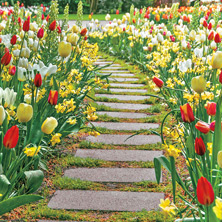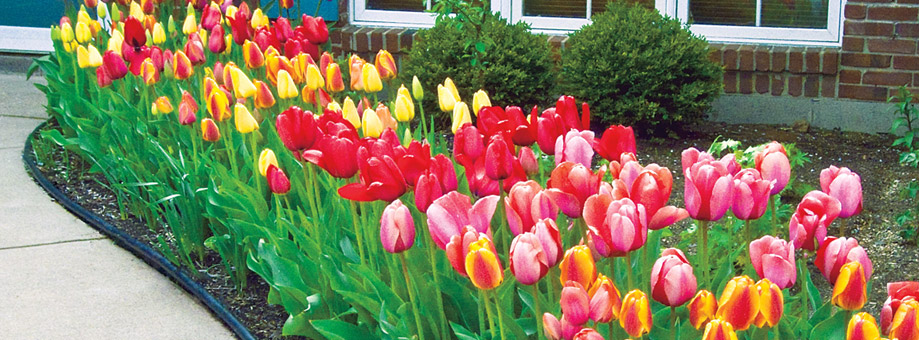Colour is one of the most exciting aspects of any garden. Your garden may
bloom in every colour of the rainbow or just one or two. But before you
start mixing colours, let's review
the basics of colour theory. Colours give us a feeling or perception of
either warmth or coolness. Cool colours are shades of blue and violet.
Warm colours are shades of red,
yellow and orange. Warm colours are perceived as advancing while the cool
colours seem to recede. Cool coloured flowers will recede even more if
they are placed in the shade.
The perception created by warm or cool colours can be used in planning your flower beds. When planted at a distance, warm coloured flowers will appear closer while cool coloured flowers will appear farther away. A planting of cool coloured flowers at the rear of the yard will make the yard seem larger. Warm coloured flowers planted in the rear of the yard will make the yard seem smaller. Plant cool coloured flowers closest to the point from which they will be viewed since cool colours are best viewed close up. Cool coloured flowers are very effective near a patio or next to a sidewalk. Warm coloured flowers are effective in bringing a distant part of the yard into focus. Warm colours will create a dramatic display in any yard or garden and will draw attention in the landscape. Neutral colours include browns, grays and greens.
 Mixing opposite colours makes each colour stand out even more. Or, try mixing perennials with bulbs to
really spice up your landscape. Try yellow
daffodils with green hosta or purple
alliums mixed with daylilies
and irises.
Mixing opposite colours makes each colour stand out even more. Or, try mixing perennials with bulbs to
really spice up your landscape. Try yellow
daffodils with green hosta or purple
alliums mixed with daylilies
and irises.
Experiment with colours by cutting a few pictures out of garden catalogs and rearranging them. To help tie different sections together, repeat a few colours throughout the garden. Try cool colours with a few sparks of warm colours, or warm colours with a few cool colours.
Multicoloured flowers, such as Zoey Rey Dahlia, Monsella Tulip and many Daffodils and Lilies, can also give you a few clues about mixing colours. After all, who knows better than Mother Nature?
Whatever colour scheme you decide upon, it's important to plant in masses of colour. In other words, plant each flower in groups of at least three to twelve flowers. Otherwise, the different colours may not have much impact.
The perception created by warm or cool colours can be used in planning your flower beds. When planted at a distance, warm coloured flowers will appear closer while cool coloured flowers will appear farther away. A planting of cool coloured flowers at the rear of the yard will make the yard seem larger. Warm coloured flowers planted in the rear of the yard will make the yard seem smaller. Plant cool coloured flowers closest to the point from which they will be viewed since cool colours are best viewed close up. Cool coloured flowers are very effective near a patio or next to a sidewalk. Warm coloured flowers are effective in bringing a distant part of the yard into focus. Warm colours will create a dramatic display in any yard or garden and will draw attention in the landscape. Neutral colours include browns, grays and greens.
 Mixing opposite colours makes each colour stand out even more. Or, try mixing perennials with bulbs to
really spice up your landscape. Try yellow
daffodils with green hosta or purple
alliums mixed with daylilies
and irises.
Mixing opposite colours makes each colour stand out even more. Or, try mixing perennials with bulbs to
really spice up your landscape. Try yellow
daffodils with green hosta or purple
alliums mixed with daylilies
and irises.
Experiment with colours by cutting a few pictures out of garden catalogs and rearranging them. To help tie different sections together, repeat a few colours throughout the garden. Try cool colours with a few sparks of warm colours, or warm colours with a few cool colours.
Multicoloured flowers, such as Zoey Rey Dahlia, Monsella Tulip and many Daffodils and Lilies, can also give you a few clues about mixing colours. After all, who knows better than Mother Nature?
Whatever colour scheme you decide upon, it's important to plant in masses of colour. In other words, plant each flower in groups of at least three to twelve flowers. Otherwise, the different colours may not have much impact.











